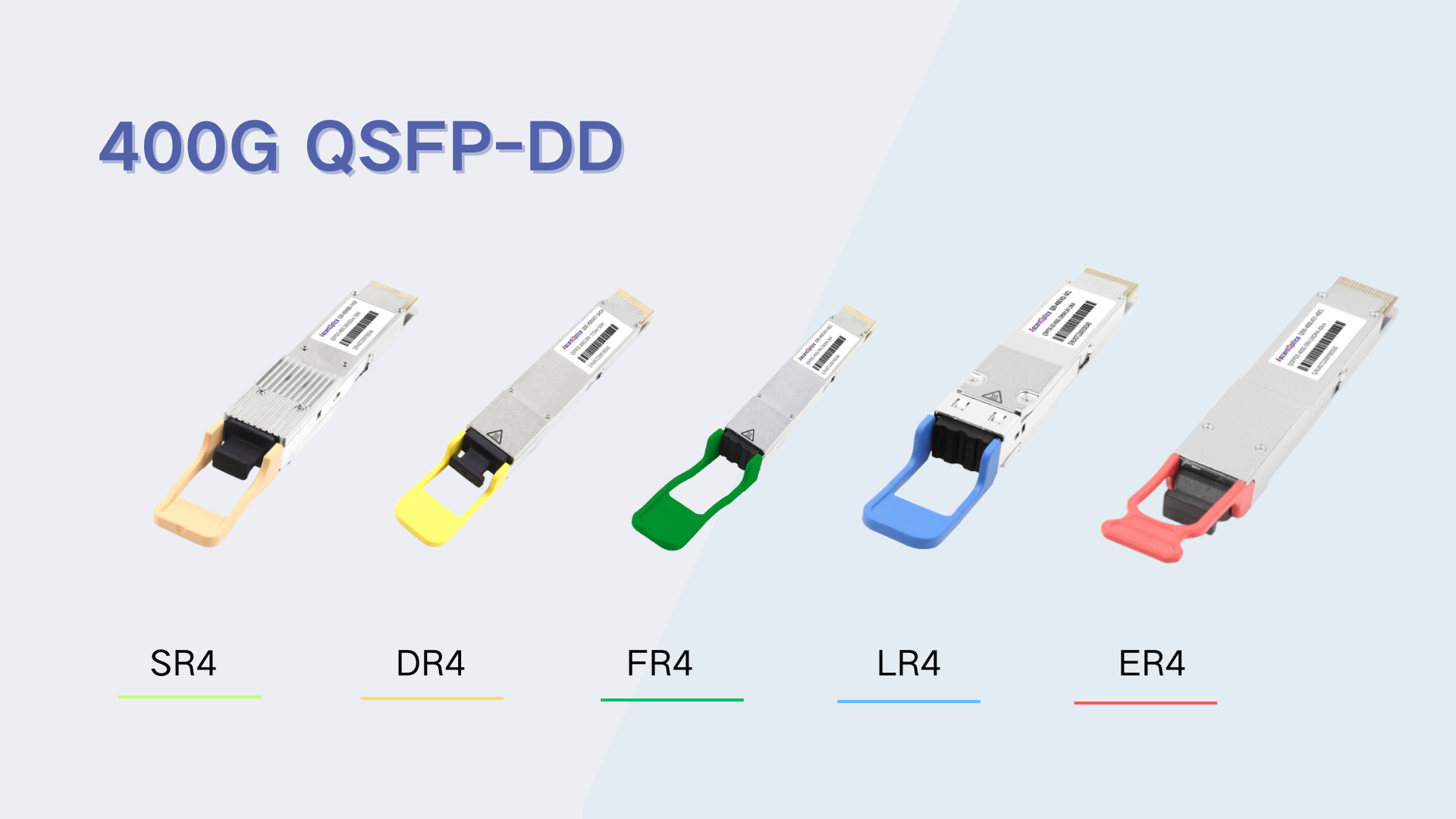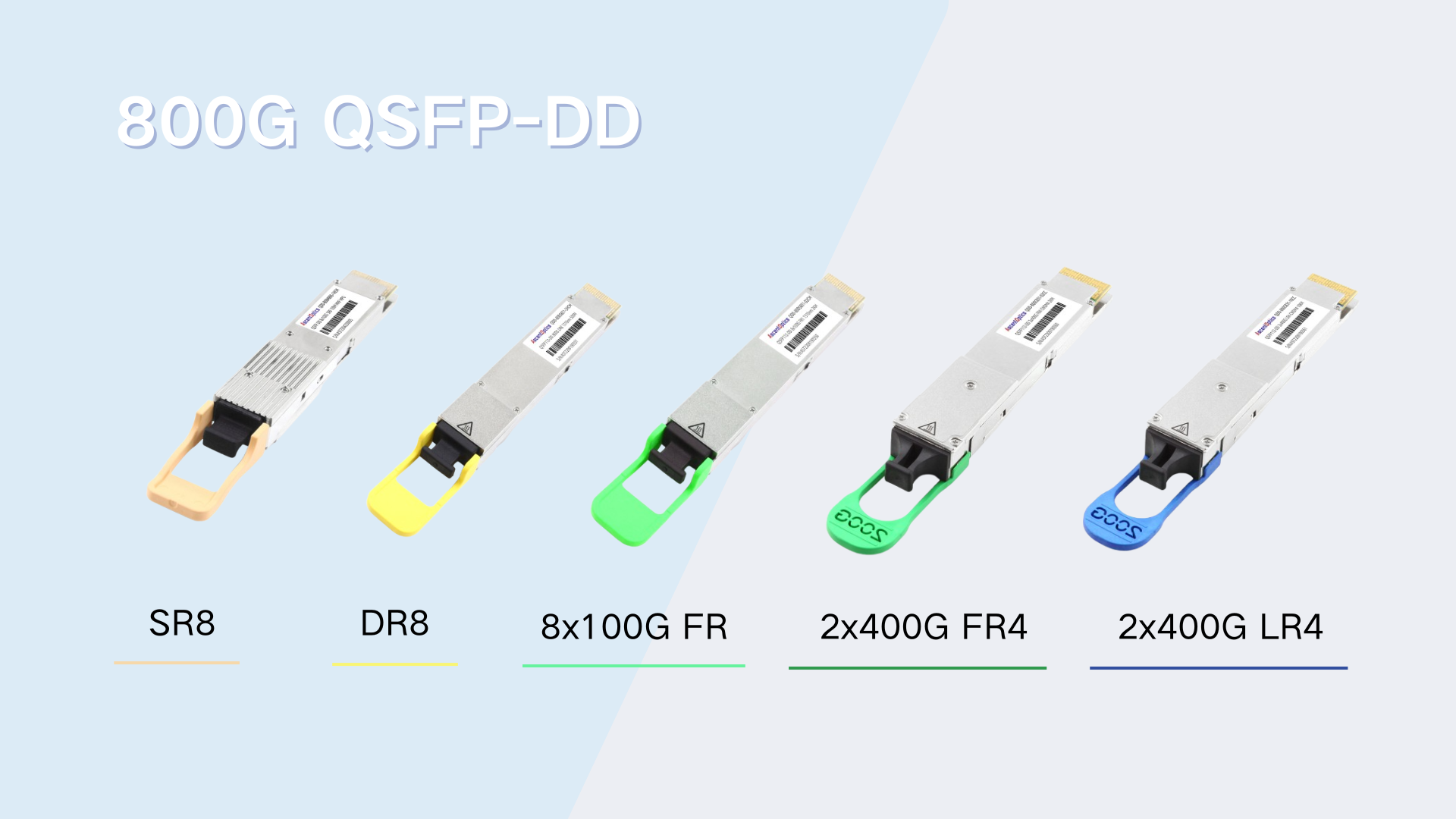According to market analysis, by 2025, global data center traffic is expected to reach tens of zettabytes, driving widespread adoption of 400G and 800G technologies. As a double-density form factor, QSFP-DD (Quad Small Form-Factor Pluggable Double Density) has become the mainstream choice. By increasing channel density, it enables higher port utilization and seamless upgrades on existing infrastructure. As a core component of high-speed networks, QSFP-DD optical modules have become the standard form for 400G and 800G Ethernet transmission.
What is QSFP-DD?
QSFP-DD (Quad Small Form-Factor Pluggable Double Density) is a double-density compact pluggable optical module defined by the QSFP-DD MSA (Multi-Source Agreement) consortium. It provides an 8-lane electrical interface through a double-density design, supporting higher bandwidth density. It offers good backward compatibility, seamlessly supporting QSFP+, QSFP28, and QSFP56 modules, facilitating existing network upgrades and reducing costs. It is primarily used for 400G, 800G, and even higher-speed Ethernet transmission, such as in data centers and telecommunications network.
Difference Between 400G and 800G QSFP-DD
400G QSFP-DD is based on 8×50Gbps PAM4 modulation, delivering up to 400Gbps bandwidth. It is primarily used for short- to medium-reach applications. 800G QSFP-DD leverages 8×100Gbps PAM4 modulation, supporting up to 800Gbps bandwidth, with a focus on long-reach and higher power applications.
The 400G QSFP-DD optical module leverages PAM4 (Pulse Amplitude Modulation) technology and supports both multimode fiber (MMF) and single-mode fiber (SMF) transmission media. Depending on deployment requirements, it is available in several variants: SR8 for short-reach connections up to 100m over MMF, DR4 for 500m over SMF, FR4 for 2km, and LR4 for 10km.
These modules are offered with a variety of connector options such as MPO-12, MPO-16, or LC duplex. Their maximum transmission distances range from 100m on MMF to 120km on SMF under the ZR standard. Power consumption typically falls between 10–12W, and the modules are fully compliant with IEEE 802.3bs/cd standards.

The 800G QSFP-DD optical module takes performance a step further by adopting higher-order PAM4 modulation at 100Gbps per lane. It supports both MMF and SMF, making it particularly suitable for long-reach and high-capacity transmission. Common variants include SR8 for short-reach, 2DR4 for 500m, and 2FR4 for 2km over SMF. Connector types primarily include MPO-16 and Dual CS. With power consumption ranging from 12–15W, thermal management becomes a critical design factor, and these modules integrate optimized heat dissipation solutions to enable reliable operation in high-density deployments.

From a technological perspective, both 400G and 800G QSFP-DD modules benefit from significant advancements. Silicon photonics has played a key role in reducing cost and power consumption, while coherent optical technologies such as ZR and ZR+ have extended transmission distances to cover metro and even long-haul applications. Moreover, compliance with international standards including IEEE 802.3bs/cd, OIF CEI-112G, and the QSFP-DD800 MSA ensures robust interoperability across different vendors and networking platforms.
| Feature | 400G QSFP-DD | 800G QSFP-DD |
| Modulation | PAM4 | PAM4 (higher order) |
| Per-lane Speed | 50Gbps | 100Gbps |
| Fiber Type | MMF / SMF | MMF / SMF |
| Common Variants | SR8 (100m), DR4 (500m), FR4 (2km), LR4 (10km), ZR (120km) | SR8, 2DR4 (500m), 2FR4 (2km) |
| Connector Options | MPO-12, MPO-16, LC Duplex | MPO-16, Dual CS |
| Reach | 100m – 120km | 100m – 2km (longer with coherent) |
| Power Consumption | 10–12W | 12–15W |
| Standards Compliance | IEEE 802.3bs/cd | IEEE 802.3bs/cd, OIF CEI-112G, QSFP-DD800 MSA |
While QSFP-DD optical modules are driving the rapid evolution of high-speed networks, their adoption comes with both significant benefits and practical hurdles.
Advantages
QSFP-DD modules deliver high bandwidth density, supporting up to 14.4Tb/s per slot. Their backward compatibility allows seamless integration with existing QSFP infrastructures, reducing upgrade costs. In addition, they provide strong flexibility by supporting multiple transmission distances and protocols (such as Ethernet and InfiniBand). Combined with cost efficiency, these advantages make QSFP-DD a preferred solution for scaling modern data centers.
Challenges
However, the deployment of QSFP-DD modules also faces notable challenges. Power consumption and thermal management remain major concerns, as 800G modules require more efficient cooling solutions, potentially involving additional systems. Compatibility considerations—such as adaptation with other form factors like OSFP—add to the complexity. Furthermore, deployment planning must account for fiber type selection and cabling optimization, which can increase operational difficulty.
The 400G/800G QSFP-DD optical modules leverage a double-density design to deliver higher port density and bandwidth, while supporting PAM4 modulation technology to handle massive data traffic. In general, 400G QSFP-DD modules are mainly deployed for short- to medium-reach interconnections, whereas 800G QSFP-DD modules are tailored for ultra-high bandwidth demands such as AI training and cloud computing. The following outlines the specific application scenarios of these optical modules:
Data centers represent the primary application domain for 400G/800G QSFP-DD modules, particularly in hyperscale and multi-tenant environments. These modules enable high-density deployments to meet the bandwidth demands of cloud services, AI, and big data processing.
Short-Distance and Intra-Rack Interconnections: Within data centers, 400G QSFP-DD SR8 or DR4 modules are commonly used for short-distance transmission (100m to 500m) from servers to switches, employing multimode or single-mode fiber. They provide low latency and high bandwidth, supporting parallel computing in AI training clusters.
For instance, in hyperscale data centers like those of Google or AWS, 400G modules can achieve aggregated bandwidths of up to 14.4Tb/s per slot, significantly reducing power consumption and costs. 800G QSFP-DD SR8 modules extend to inter-rack interconnections, ideal for high-performance computing (HPC) in the AI era, such as NVIDIA’s DGX systems, where they handle massive GPU data exchanges with latency reduced to microseconds.
Data Center Interconnect (DCI): For cross-data center connections, 400G ZR/ZR+ modules support long-distance transmission (up to 120km) without additional amplifiers, suitable for metro network interconnections. 800G modules like 2FR4 extend to even farther distances, leveraging coherent optics for low-power point-to-point transmission. In practical deployments, Microsoft Azure data centers utilize 400G QSFP-DD to link multiple sites, facilitating cloud migration and backups with cost benefits over traditional 100G solutions.
By 2025, with the surge in AI applications, the adoption rate of 800G modules in DCI is expected to exceed 50%, driving migrations to higher speeds.
Telecommunications operators leverage 400G/800G QSFP-DD modules to build efficient backbone and metro networks, supporting 5G infrastructure and long-haul transmission.
Backbone and Metro Network Transmission: 400G LR4 or ER4 modules are used for medium-to-long-distance (10km to 40km) telecom links, providing high bandwidth to handle video streaming and IoT data. 800G modules like 2DR4 target backbone networks, supporting 800Gbps rates for high-speed aggregation.
For example, telecom giants like China Mobile deploy 800G QSFP-DD to upgrade core networks, reducing node counts and operational costs. In metro networks, these modules integrate with DWDM (Dense Wavelength Division Multiplexing) technology to enable multi-wavelength transmission, expanding capacity to several Tb/s.
Data Center and Telecom Interconnections: 400ZR/800ZR coherent modules are crucial for directly linking data centers with telecom networks, supporting unamplified transmission over hundreds of kilometers. They simplify traditional DWDM system complexities, ideal for edge-to-core interconnections. In European telecom networks, 800G modules have been deployed to support remote healthcare and real-time monitoring applications, ensuring low latency.
400G and 800G QSFP-DD optical modules play a key role in high-bandwidth, low-latency networks, with their technical advantages and flexibility making them the preferred choice for data centers and telecommunications networks. Leveraging high density, flexibility, and strong evolution potential, it will continue to lead the development direction of high-speed optical communications in the future and lay the foundation for 1.6T and even higher-speed network upgrades.
A: Common 400G types include SR8, DR4, FR4, LR4, and ZR; 800G types include SR8, 2DR4, and 2FR4. They cover transmission distances from 100 meters up to 120 kilometers.
A: These modules are widely used in data centers (AI clusters, cloud computing), telecom networks (backbone, metro), and data center interconnects (DCI).
A: Key challenges include higher power consumption, thermal management, compatibility with other form factors (like OSFP), and complex fiber cabling requirements.